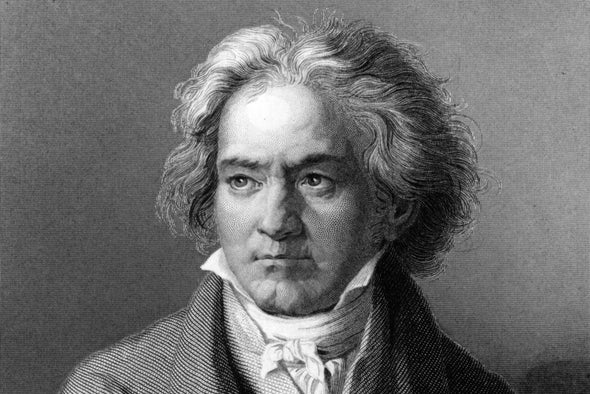(单词翻译:单击)
听力文本
This is Scientific American's 60-second Science, I'm Christopher Intagliata.
Beethoven is a giant of classical music. And the most influential, too—at least, when it comes to piano compositions. That's according to a study in the journal EPJ Data Science.
If you're wondering how data analysis could determine something as intangible as cultural influence, it's worth remembering this:
"The great thing about music: it's the most mathematical of the art forms we actually can deal with. Because a lot of it is symbolic; it's temporal. So we have symbols. The music is written in symbols that are connected in time."
Juyong Park is a theoretical physicist by training and associate professor of culture technology at the Korea Advanced Institute of Science and Technology.
Park and his colleagues collected 900 piano compositions by 19 composers spanning the Baroque, Classical and Romantic periods, from 1700 to 1910.
(CLIP: Musical montage)
Then they used that mathematical quality to their advantage by dividing each composition into what they called "code words," a group of simultaneously played notes—in other words, a chord.
(CLIP: Code word sample)
They then compared each chord to the chord or note that came after it...
(CLIP: Code word transition sample)
...which allowed them to determine how creative composers were at coming up with novel transitions.
The composer with top marks for novelty? Rachmaninoff.
(CLIP: Rachmaninoff sample)

But when the researchers looked at those chord transitions across all 19 composers, it was Beethoven who was most heavily borrowed from—meaning, at least among the composers in this analysis, his influence loomed the largest.
Their study comes with a couple caveats. Again, the researchers only considered piano compositions in this work—not orchestral works. And by only studying chord transitions, their conclusions wouldn't capture artists who were influential in other ways.
"It's well understood that Mozart's contribution to music comes from the musical forms that he devised. That was not very well captured by our mathematical modeling."
As for Park, the results convinced him he has some listening to do.
"Of course I do. I like Rachmaninoff's music but I have to confess, I have listened to Beethoven way more than Rachmaninoff. So after this work came out, I ended up buying his whole complete collection from Amazon, I'm waiting for this collection to arrive."
Seems that Park turned a minor interest into a major commitment—in a key way.
(CLIP: Rachmaninoff sample)
For Scientific American's 60-second Science. I'm Christopher Intagliata.
参考译文
这里是科学美国人——60秒科学系列,我是克里斯托弗·因塔格里塔。
贝多芬是古典音乐的巨人。同时也是最有影响力的人物,至少在钢琴作曲方面。这是发表在《欧洲物理学报·数据科学》期刊上的一项研究得出的结论。
如果你想知道数据分析如何确定文化影响这种无形事物,那下面这句话值得记住:
“音乐的伟大之处在于:它是我们能处理的最具数学性的艺术形式。因为许多音乐是符号性、时间性的。因此,我们拥有符号。音乐由节奏连接的符号写成。”
朴具勇是职业理论物理学家,也是韩国高级科学技术院的文化技术副教授。
朴具勇及其同事收集了19位作曲家创作的900首钢琴作品,时间从1700年到1910年,横跨巴洛克、古典和罗曼蒂克时期。
[音频剪辑:音乐片段]
之后,他们利用其数学特性,将每首作品分成所谓的“暗语”,即一组同时演奏的音符,也就是和弦。
(音频剪辑:代码词示例)
然后,他们将每个和弦及其后面的和弦或音符进行比较。
(音频剪辑:代码字转换示例)
这使他们得以判断作曲家在创作新变调方面的创造力水平。
那创造力最强的作曲家是谁?拉赫玛尼诺夫。
(音频剪辑:拉赫玛尼诺夫作品样本)
但是,当研究人员观察所有19位作曲家的和弦变调时,发现他们借鉴最多的是贝多芬,也就是说,至少在这次分析的作曲家中,贝多芬的影响最大。
他们的研究提出两个注意事项。研究人员这次也只考虑了钢琴作品,而不是管弦乐队作品。另外,由于仅研究和弦变调,他们的结论并未提及以其他方式产生影响的艺术家。
“众所周知,莫扎特对音乐的贡献是他对典式的设计。而我们的数学模型未充分体现这一点。”
至于朴具勇,研究结果让他相信他得听些音乐了。
“我当然会听。我喜欢拉赫玛尼诺夫的音乐,但我得坦白,我听贝多芬比听拉赫玛尼诺夫多多了。因此, 这篇研究发表后,我最终在亚马逊上买了拉赫玛尼诺夫作品集,现在我正在等快递送来。”
似乎朴具勇将次要(小调)爱好转为了主要(大调)任务——从音调方面而言。
(音频剪辑:拉赫玛尼诺夫样本)
谢谢大家收听科学美国人——60秒科学。我是克里斯托弗·因塔利亚塔。
译文为可可英语翻译,未经授权请勿转载!
重点讲解
重点讲解:
1. when it comes to 谈到;涉及;
When it comes to music, I'm a complete ignoramus.
说到音乐,我完全是个门外汉。
2. to one's advantage (尤指转变不利情况使之)对…有利;
It would be to your advantage to attend this meeting.
参加这次会议会对你有利。
3. divide into (使)分开;
The physical benefits of exercise can be divided into three factors.
运动对身体的好处可以分为3个方面。
4. come up with 想出,提出(计划、想法等);
Howard Wilkinson has come up with an absolute corker of an idea.
霍华德·威尔金森想出了一个绝佳的主意。


